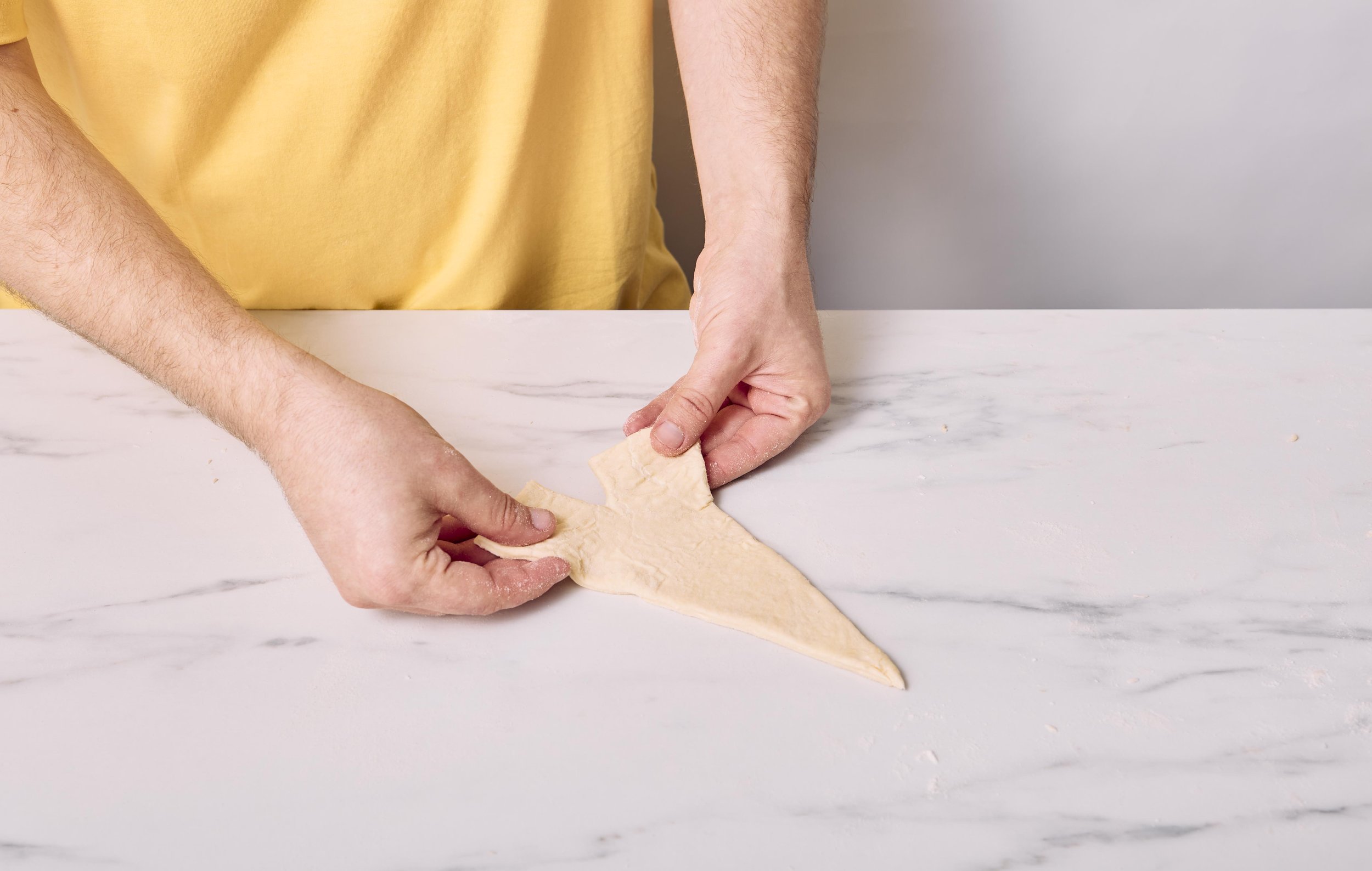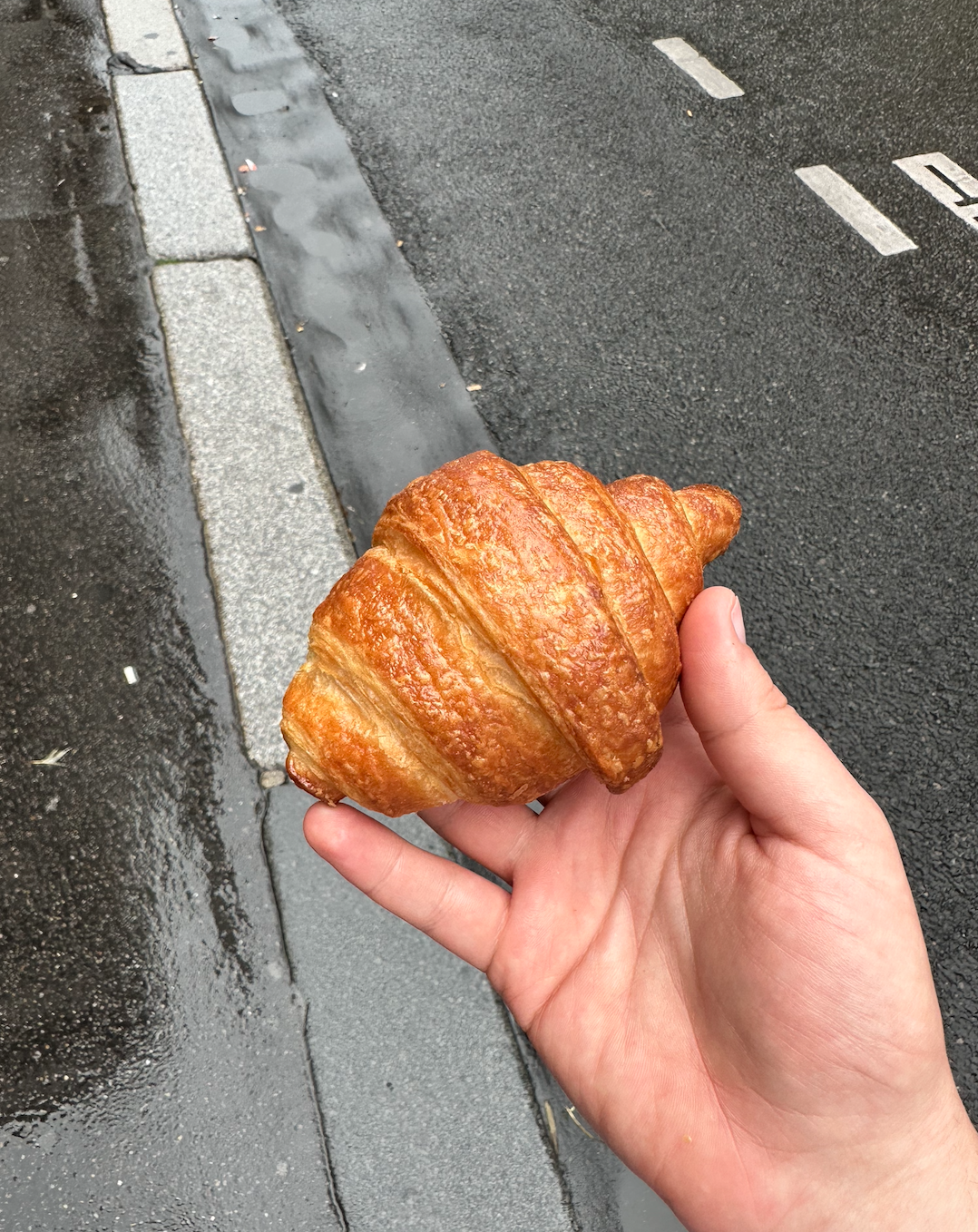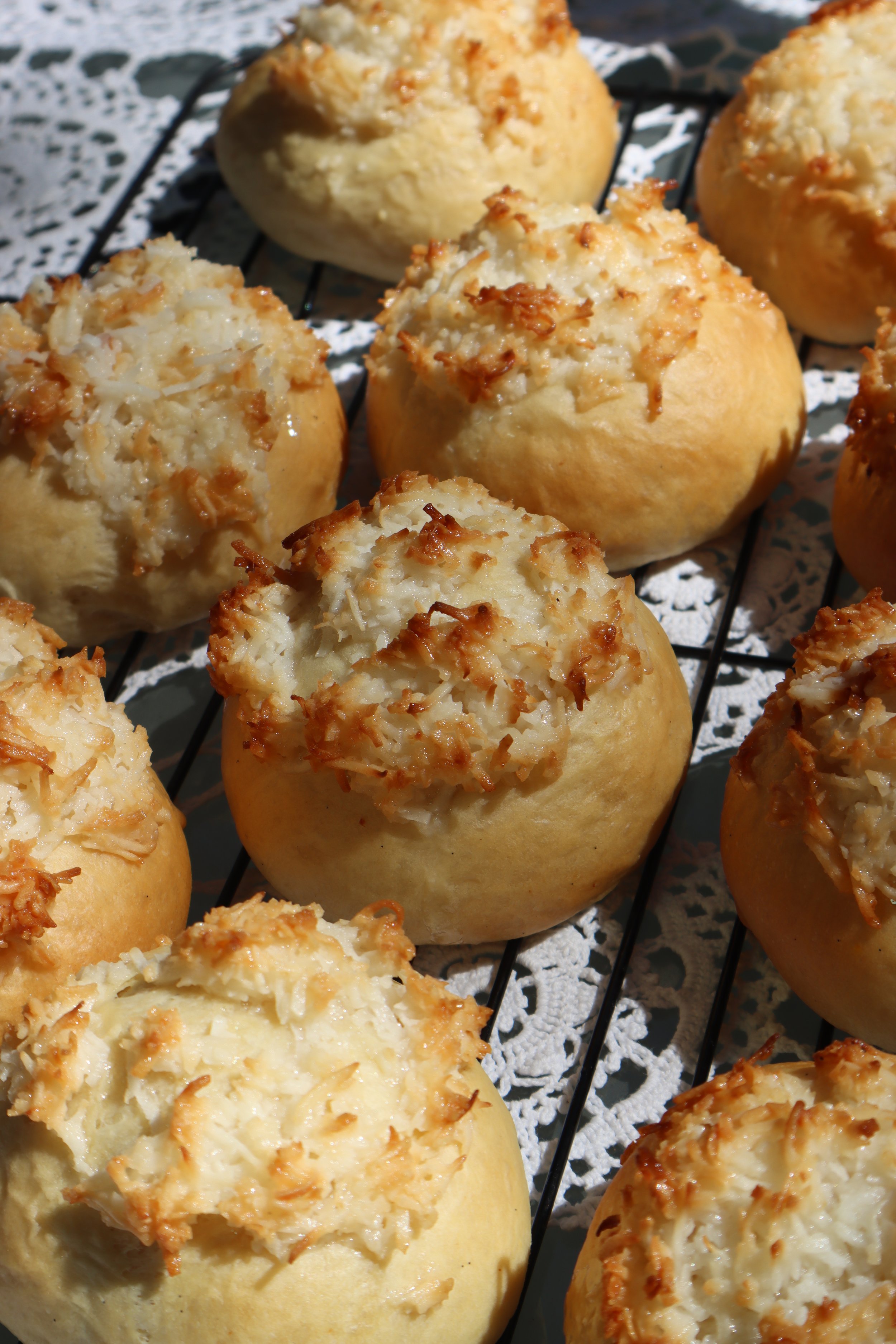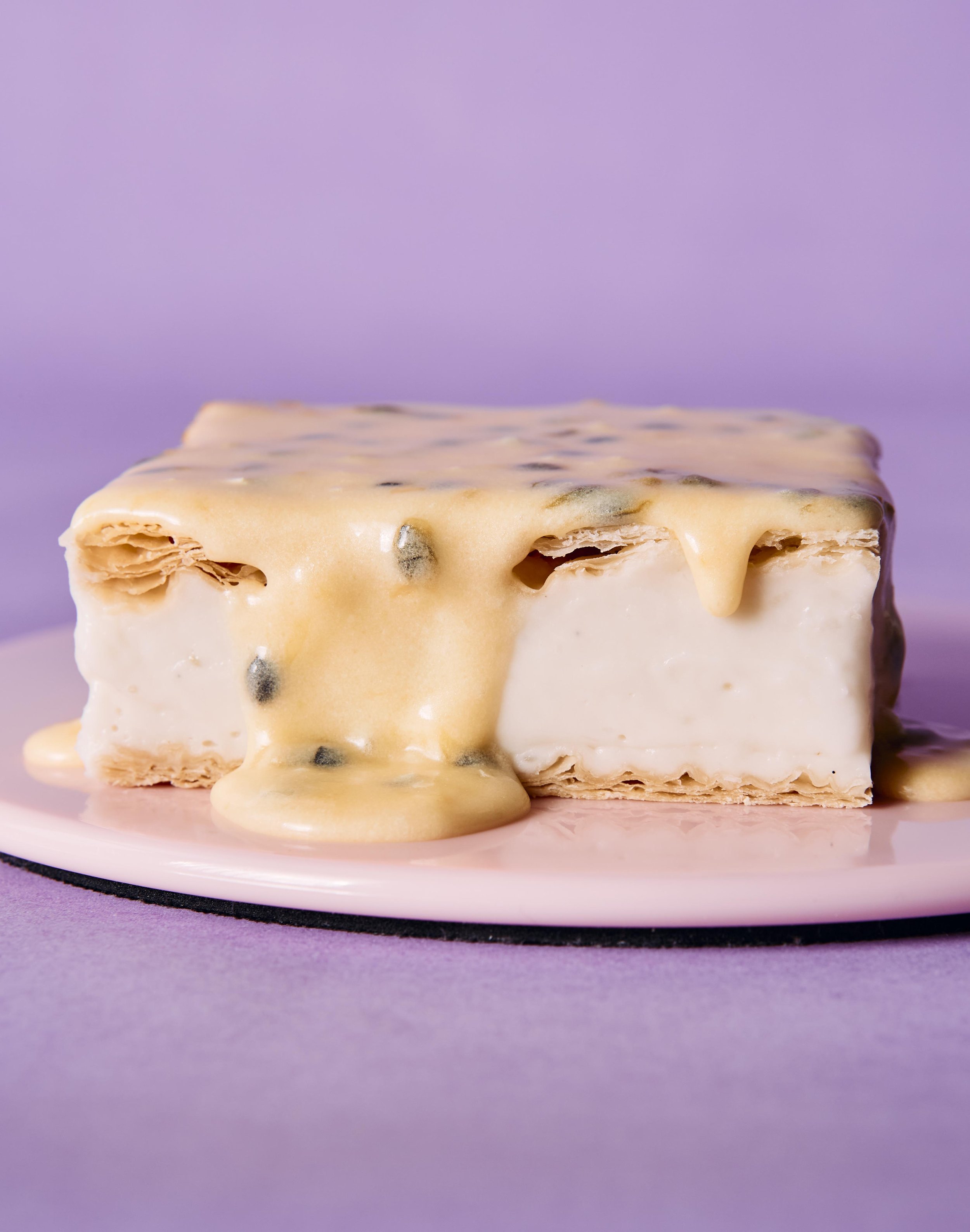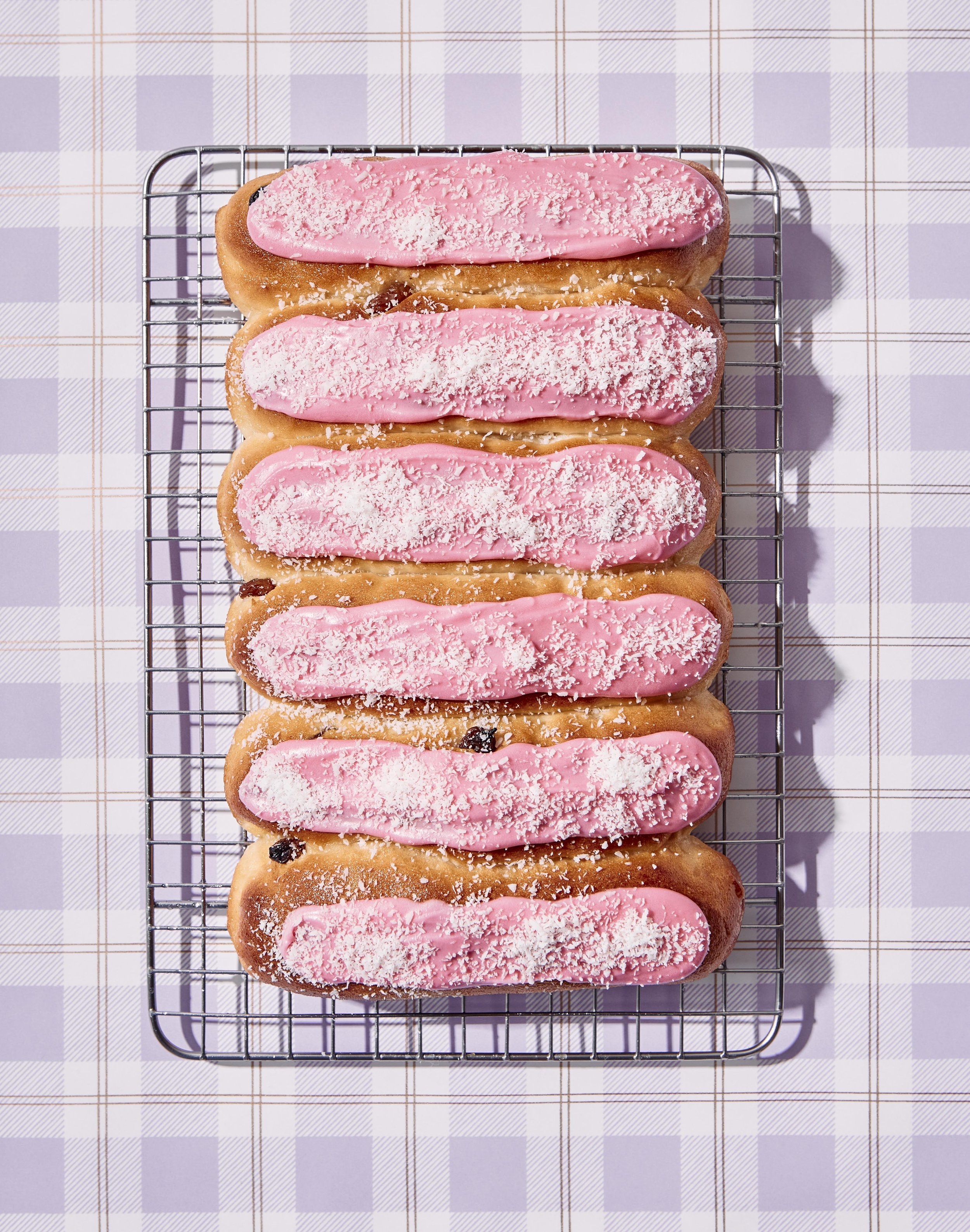VEGAN CROISSANTS
BUTTERY, FLAKY CROISSANTS
FROM THE PASTRY CHAPTER
OF THE VEGAN BAKER
This is a big kitchen project, but oh what a glorious one.
So if you’re up for the quest that is hand making croissants from scratch, at home (a formidable challenge) AND WITHOUT DAIRY.. then this is the guide you need to accompany you along the way. Croissant-making isn’t a fleeting impulse, it’s a lifestyle choice that will demand all of your bench space, gobble up every spare inch of your fridge and perhaps.. even possibly take your sanity by the end. I’m using dramatic effect here, but the point stands. The process invites you to take your sweet-ass time for best results with a recipe that can take up to three days (oui! Trois jours!) before bearing its heavenly fruit.
This behemoth of baking is just that, because croissants combine the perfection demanded by laminating fat with introducing yeast to make the dough swell up in a honeycomb-style crumb. You’ve got lots of chilling time ahead of you, so let me talk you through the important stuff you’ve gotta know to make the most French pastries ever completely, sacrilegiously and deliciously vegan.
On my first day in Paris, French vegan legend and my francophone vegan butcher counterpart Sébastien Kardinal took me out to legendary vegan boulangerie Land & Monkeys. We fueled up for a day of seeking out our respective french-edition vegan butchery cookbooks with the Frenchest breakfast there is: a fresh, plain croissant. On the rocks. Sans the filling. Hold the garnish. Still warm from the bake. My sweet, simple mind exploded.
Pre-vegan, my croissant experience was largely that of the ham-cheese-tomato variety that had sat in a cabinet for a good stint before being rewarmed, but this was something else. So fresh, so buttery, so flaky! Of course it wouldn’t need anything else if you’ve got the perf plant based pastry. How could you ever have a bad day when you start off with the most indulgent thing possible? But for those of us who don’t live in France and can’t wander down the street for a fresh croissant made with dairy-free butter, we’ve got to do a little (jk, it’s a lot) more work to enjoy the same experience. Mais oui, c'est possible!
So, what’s the lowdown on making vegan croissant dough?
To start, we make a yeasted dough that has a little fat, sugar and plant milk in it (I use almond milk for my croissant recipe): this is called the détrempe. Then you take a block of vegan butter into your proverbial parking lot (kitchen) to beat it up until it submits into a neat rectangle or square. This butter block is called the beurrage.
It’s made of nothing but vegan block butter and this is your first hurdle to get past. This pedantic process ONLY works with vegan BLOCK butter (specifically not tub margarine). The kind that is suitable for this pastry comes as a rectangle of vegan butter wrapped in foil or non-stick paper). Generally, the malleable solidity of BLOCK BUTTER at cold temperatures is crucial to the process, something that spreadable/tub margarine can’t yet replicate. Otherwise the dough won’t be able to retain its layers during repeated folding. The brand I use is called Naturli.
The first step is enclosing the beurrage in the détrempe so that it is totally covered. Then, after a chill in the fridge, it’s lamination time. Letter folds are the simplest lamination fold, as croissants have less layers than other laminated pastries that use book folds like puff pastry dough/pâte feuilletée). All folds start by rolling or pressing out the croissant dough into a rectangle. The letter fold then calls for the dough rectangle into thirds as though you’re folding a piece of paper to fit in an envelope, then gently pressing down to adhere the layers. After three of these folds, your laminated dough is ready to be shaped into croissants.
But how do you make a great vegan croissant dough?
The key is keeping the pastry – and specifically, the fat in it – as cold as possible to preserve the individual layers as the folding steps happen. That means emerging at night like a raccoon, baking these in the cool months, switching on the air conditioner in the hot months, and anything that helps the dough stay cold. Your best bet – hence the agonising amount of wait time – is to rest the dough in the fridge between every action, which also serves the dual purpose of giving the gluten in the flour time to relax between rolls. During baking, the fat in the butter melts, which basically ‘fries’ the dough and puffs the pastry up - which is why croissants taste so good. Well, they taste like fried butter so make sure you pick the very best vegan butter you can find for this.
Every seemingly bewilderingly specific step is for good reason: to turn out perfect pastry. Most of the recipe time, thankfully, is passive. Planning ahead means you can use the wide stretches of rest time to make croissants alongside all sorts of other things while you’re already in the kitchen. Take your time! Forget about the dough in between each fold and you’ll reap the rewards of more distinct layers of butter between the dough which’ll give you the ideal internal crumb.
Why does the dough have to be so cold?
The difficulty with creating perfect layers comes down to temperature because laminated dough is a plump, picky winter baby who just can’t get enough of the cold. Generally, dairy-free butter lamination requires that the détrempe (dough) and beurrage (block of fat prepared for folding) does not exceed 10°C (50°F) before proving. So, between each fold, the détrempe is kept in the fridge to stop the temperature exceeding the fat’s melting point.
Other strategies I’ve used to help keep the dough cold include taking advantage of winter months, rugging myself up in a room with the air-conditioning on full blast, working late at night, freezing silicone baking mats to work on, or using a bag of ice to cool my workbench. Put simply, the more uncomfortable you are, the happier the dough, the crisper the layers, and the faster you can laminate.
In particularly cold environments, the wait time between folds can be reduced to performing two back-to-back folds at a time. However, when starting out, it’s better to err on the side of longer rest periods to keep your layers clean as you learn the process. For more certainty, a temperature gun can help you check if your dough is still cold enough as you fold.
How do you make vegan croissants look like croissants?
After rolling out the dough one last time, you use a pizza slicer to cut the dough into triangles. The reason we use a pizza slicer is to help preserve the laminated butter layers without pushing down on the dough. The cleanly cut edges of croissants cut with a pizza cutter rise much more nicely in the oven.
I may be a dramatic romantic with this, but the beauty of croissant making is in the shaping. You cut tall triangles and stretch out the base to form a little Eiffel Towers. A fleeting glimpse of Paris as you bake your way to a Parisian breakfast. Then, from the base, you simply very gently roll up the towers until you get to the tip. You can secure it on with a wet finger or squash it slightly and roll the tip under the weight of the croissant as you let it rise.
After a few hours (depending on the ambient temperature where they’re being risen in) and once the croissants jiggle when shaking lightly and you can see risen layers of butter in the edges, they’re ready for a hot oven. We start the oven at 200c (fan forced) because it’s a laminated dough so we want the layers of butter cook quickly at the beginning. Once the croissants are in, the temperature is reduced to 180c so that they don’t brown too fast. Within 30 minutes, hot croissants are ready to go, but you’ll definitely want to give them a slight cool so you can see the crumb structure you worked so hard to build.
Congrats! If you’ve gotten here, you’ve accomplished an amazing feat and made your first plant based croissant.. at home! Not many can say they’ve pulled that off. Go on, treat yourself with another croissant reward and start your next dough batch (after all, it’s 3 days before your next lot will be ready). You came to Paris to fall in love but I bet you never realised it would be with the constant laminating loop that is the croissant baker’s lifestyle. Bienvenu.
Le moment précis où j'ai mangé mon premier croissant à Paris avec mon copain Sébastien Kardinal!
The photographic guide to laminating pastry and recipes on this page are extracted from The Vegan Baker photographed by Emily Weaving. Join me on each tricky step so you can master this technique at home without using any butter!
Make a beurrage (bashed block of butter).
Make sure the dough and butter block are very cold. You’ll need to make sure you use dairy-free BLOCK butter (not from a tub) for this technique.
Enclose it in the détrempe (croissant dough).
Return it to the fridge to chill out before starting the laminating process. Also, between each and every step unless you live somewhere that’s under 10 degrees celsius so that the dough doesn’t warm up and melt the butter.
Prepare for your first tour of the pastry.
Use a rolling pin to press out, then roll out the dough with the butter inside. Dust the pastry with flour, then use a brush to dust off the excess as you go so that it stays pliable but not floury.
Perform a letter fold by folding like the dough needs to fit an envelope.
You fold the bottom third of the dough over, then fold the top third over that. Use a rolling pin to tap the dough lightly then get it straight back into the fridge.
Repeat three times until there’s 55 layers of butter laminated into the dough.
Turning the dough between each lamination creates the honeycomb crumb structure signature to croissants. After enclosing the beurrage in détrempe, perform 3 total letter folds with rests between.
Cut the pastry into triangles with a pizza slicer.
The pizza slicer helps to preserve the layers in the dough at this delicate point! The edges of the triangle base will be the edges of your croissant.
Pull out the bottom to create a tiny pastry Eiffel Tower.
This is my favourite part! Pour voir la tour eiffel un seul instant.
Begin to very gently roll up from the base.
Stretch each side of the tower base out, roll them up (don’t press down though) from each side to meet before switching to using you palm to roll the tower up to the tip.
Gently pull out the other end as you roll towards it.
Be gentle the whole time so as to not interrupt the butter layers you worked so hard on.
Roll the tips under and let them rise before baking.
Rest them with the tip of the Eiffel towers sitting underneath to preserve their shape. You can also use a light dab of water to secure the tips on if you need. Drag any long ends around into a crescent shape and let them rise until they jiggle.
Want to make almond croissants (vegan croissant aux amandes)?
Repurpose croissants that have passed the two-day event horizon of freshness by halving them, smearing Crème d’amande (page 246 of The Vegan Baker or below) in the middle and closing them up again. Dunk the croissants in Rum syrup (page 249 of The Vegan Baker or below). Smear a small amount of crème d’amande on top of each croissant, and press flaked almonds on top. Resuscitate in a preheated 160°C (320°F) oven for 20–25 minutes, turning on the oven grill (broiler) for the last few minutes, until the almonds are gorgeously toasted.
Vegan Crème D’amande
80 g (2 3⁄4 oz) vegan butter
pinch of fine salt
zest of 1 lemon
100 g (3 1⁄2 oz) icing (confectioners’) sugar
20 g (3⁄4 oz) cornflour (cornstarch)
200 g (7 oz) fine almond meal
1 tablespoon rum
40 g (11⁄2 oz) applesauce
1 teaspoon vanilla bean paste
Begin beating the butter, salt and lemon zest in a large bowl using a hand-held electric mixer, or a stand mixer fitted with the whisk attachment. Sift together the icing sugar and cornflour and fold the mixture through the butter mixture, followed by the almond meal, then the rum, applesauce and vanilla bean paste.
Rum Syrup
80 g (2 3⁄4 oz) granulated white sugar
50 ml (1 3⁄4 fl oz) dark spiced rum
Bring the sugar and 80 ml (2 1⁄2 fl oz) of water to the boil in a saucepan over medium heat, then simmer over very low heat for 3 minutes, adding the rum for the last minute. Remove from the heat.
My first croissant in Paris! From Land & Monkeys, a totally vegan boulangerie with 6 locations in Paris, France. It’s still warm from the oven.
Holy Moly! With patience and cold temperatures, you can make holy, honeycombed croissants without dairy, too!
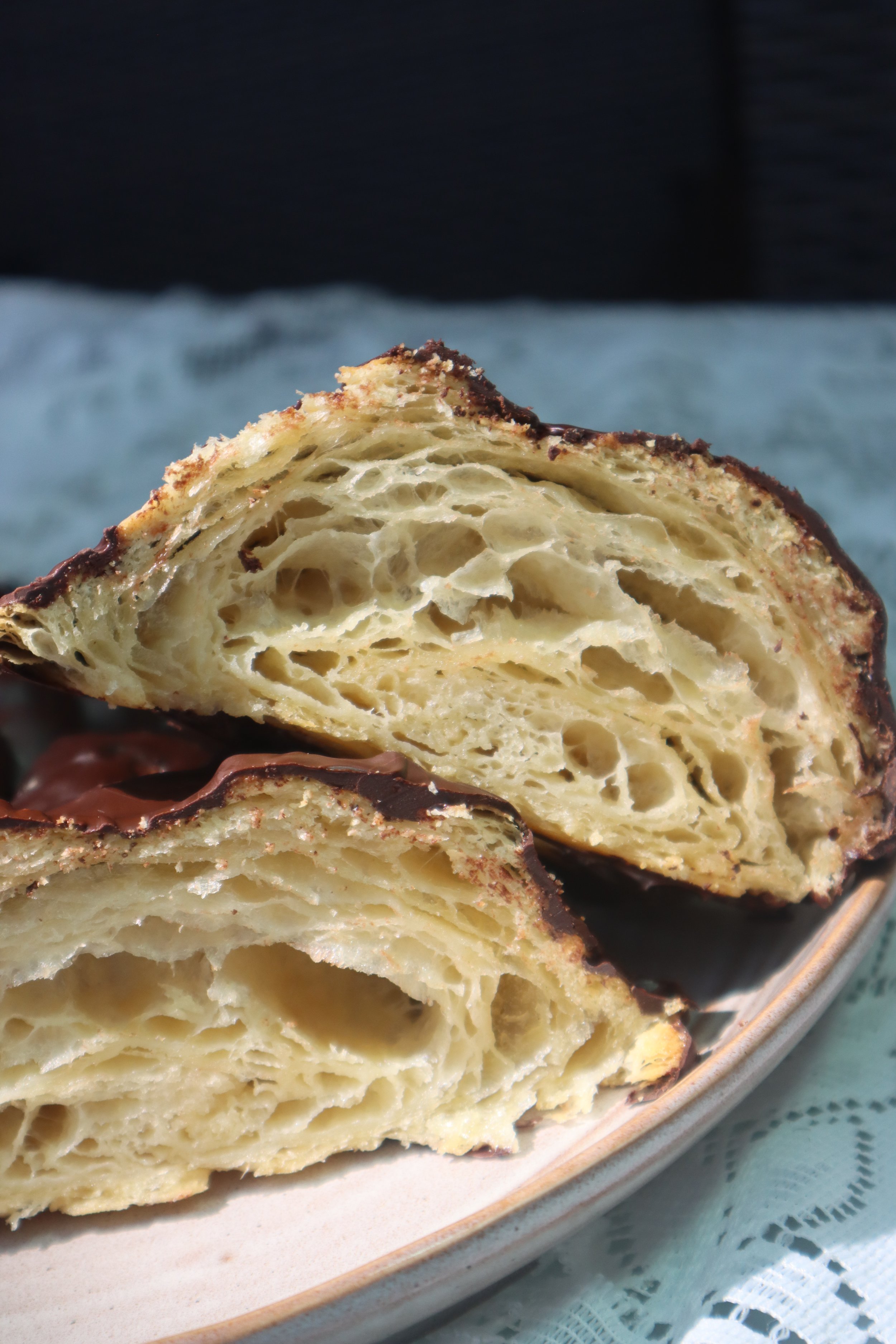
Vegan Croissants
Ingredients
- plain (all-purpose) flour, for dusting
- 2 tablespoons vegan cream or plant-based milk, for brushing
- 240 ml (8 fl oz) warm almond milk
- 14 g (5 scant teaspoons) active dried yeast
- 500 g (1 lb 2 oz) bread flour
- 40 g (11⁄2 oz) granulated white sugar
- 2 teaspoons fine salt
- 50 g (13⁄4 oz) vegan block butter, cut into cubes
- 110 ml (4 fl oz) aquafaba
- 350 g (12 1⁄2 oz) fridge-cold vegan block butter
Instructions
- Start with the détrempe (dough). Place the warm milk in a bowl and add the yeast to get ready for a long day at work, sitting in a bowl for a few minutes until frothy. Add the flour, sugar, salt and butter to the bowl of a stand mixer fitted with the paddle attachment. Mix on medium speed for 1–2 minutes, until the mixture is finely distributed into crumbs. Add the aquafaba to the milk mixture, then slowly pour into the bowl as the mixer runs. When the dough comes together, switch to the dough hook attachment and knead for another 5 to 10 minutes or until it passes the windowpane test. Wrap the dough in plastic wrap so that it is sealed, but not too tightly, as it will begin rising in the fridge. Leave to rest in the fridge for 6–12 hours.
- Prepare the beurrage (butter). Spread a sheet of baking paper over a large work surface that you can easily roll the dough out on later. Place the block of cold butter on top, and sandwich it between another sheet of baking paper. Use a rolling pin to gently bash and flatten the butter. Using a sharp knife, trim the edges to form a smooth 15 cm (6 in) square. Add the excess butter back on top, sandwich again between baking paper and beat the butter into the square, so it is nice and even. Move to the next step ONLY when the beurrage has had at least 1 hour to collect itself in the fridge.
- Sprinkle flour over your benchtop. Unwrap the chilled dough, then roll it out into a 20 cm (8 in) square. Score a square the same size as the beurrage in the centre of the dough, then use a dough scraper to cut lines from each corner of the square to the outer edge of the dough. Leaving the centre square intact, roll out the dough edges until they are large enough to fold over the centre square. Place the unwrapped cold butter block in the centre and fold each of the edges over the top, securely sealing the butter payload inside. Flip the dough over. Press or lightly beat all along the length of the dough with a rolling pin to squash it down and secure the layers. Wrap in plastic wrap and return to the fridge for 1 hour.
- Flour the benchtop again, ready to begin your first tour of the dough. You’ll need to complete three tours, each consisting of one letter fold. Unless your kitchen is really cold, completely chill the dough for 1 hour in the fridge or freezer between each tour, aiming to keep the dough at all times below 10°C (50°F). Use a pastry brush to dust excess flour from the pastry as you go, to keep an even dusting as you roll. If you’re more of a visual person, turn to page 47 of The Vegan Baker or check higher on this page for a photographic guide to your laminating dough journey.
- Working either away from or towards you – not side to side – begin by pressing the rolling pin along the length of the dough. Repeat by pressing down the spaces left between the rolling pin indentations, to flatten the whole thing, which will evenly begin to lengthen the dough in one direction. Check that both sides of the dough are adequately floured, then roll the dough carefully back and forth to give you more space to complete a fold. The more precise and neat you are at forming this rectangle and performing the first fold, the better your internal structure will be.
- Use a pastry brush to dust off excess flour, then give the dough a quarter turn so the long side is facing you. (If at any point the dough tears or butter is exposed, dust flour into the spot to ‘repair’ it, then return the dough to the fridge for at least 1 hour before proceeding.) Now perform the first letter fold. Fold the bottom third of the dough over, then fold the top third over this, as though you needed to fit the dough into an envelope. Quelle surprise: you should still use a pastry brush to dust off excess flour! With the end of the rolling pin, tap lightly and evenly all over the top of the dough to secure the layers, completing the tour of the dough. Cover in plastic wrap and get the dough straight back in the fridge for at least 1 hour to cool back down.
- Repeat steps 5 and 6 twice more to complete three full tours.
- Complete a final dusting off of any excess flour, tap the top of the dough with the rolling pin to slightly lengthen, trim the very outer folded edges with a pizza cutter – and then the dough is finally ready ... tomorrow! Cover in plastic wrap and refrigerate for at least 2 hours, or even overnight, as yet another test of your patience.
- Return the dough to the bench. Press the rolling pin along the length of the dough. Repeat for the spaces left between. Throughout this process, generously pour flour over the dough several times, dusting off just about completely. Now roll the dough in all directions into about a 45 cm × 60 cm (18 in × 24 in) rectangle, 5 mm (1⁄4 in) thick. Flip the dough regularly and re-flour as you do so, using your forearm to flip the dough over and guide it back to the benchtop when it is getting thin and large. Rest the dough for 5 minutes before proceeding.
- Use a pizza cutter to trim the dough edges, then divide the dough in half lengthways. Mark off small cuts, 10 cm (4 in) apart, along one edge of each dough half – then do the same on the other side, but mark in between the first cuts. Using these points as a guide, cut diagonally across the dough to make long triangles. Gently pull the edges out to make them even.
- Line two baking trays with baking paper or silicone baking mats. Form the croissants. With the pizza cutter, make a small incision on the fat end of a dough triangle.
- Gently stretch apart the two edges to form an adorable little Eiffel Tower! Each tip of your tower will be visible as the outside edges of your croissants, so go easy to preserve the lamination as much as possible while doing this step.
- Roll up each side of the tower’s base to meet at the end of the incision, then use your palm to gently begin rolling the croissant up. You want to be firm, but not too tight in the roll, so the layers have room to rise. Use your hand or a rolling pin to hold the thinner end of the tower and gently pull towards you to stretch out the pastry as you roll it up.
- When you come to the top of the tower, lightly pinch the top and roll the croissant over to adhere it on. (A dab of water can help if needed to reinforce it!) Position the croissant on a baking tray, with the tip side down. Drag the edges around to form a crescent shape. Repeat until you’ve used up all the croissant dough, making sure they’re generously spaced out on the tray. (If you want to freeze some or all of the croissants for later, do so now.)
- I’m so sorry to say, you’re not done yet. Cover the croissants with plastic wrap and allow to rise, at a room temperature no higher than 25°C (77°F), for 2–12 hours, until ballooned out and almost doubled in size. The rising time will vary depending on your home conditions, so check hourly during your first attempt, and remember that future croissant endeavours should be fairly consistent with how long that takes. When the croissants are ready for baking, you should be able to see the separate layers between the risen dough, when looking at the sides of the croissants.
- Preheat the oven to 200°C (400°F) and clear it of other baking trays. Brush the top of the croissants with cream or milk, trying to avoid the laminated edges of the croissants. Place the croissants in the oven, reduce the temperature to 180°C (350°F) and bake for 25–30 minutes, until gorgeously golden, rotating the trays halfway through cooking, brushing extra cream or milk on any spots that aren’t browning fast enough and monitoring closely towards the end (smaller croissants may need to be removed from the 15-minute mark).
- Remove from the oven and leave to cool for 10 minutes on the trays, then move to wire racks to cool fully before slicing, so the crumb can set properly. Félicitations, c’est la fin! Eat within 2 days, or use old croissants to make almond croissants (see instructions on this page).
Nutrition Facts
Calories
308.43Fat
2.08 gSat. Fat
0.49 gCarbs
55.21 gFiber
2.18 gNet carbs
53.03 gSugar
8.08 gProtein
16.25 gSodium
975.85 mgCholesterol
6 mgThe Vegan Baker by Zacchary Bird
This recipe is from the Pastry chapter of my cookbook The Vegan Baker! It’s the ultimate guide to plant based pastries, breads, cookies, muffins, doughnuts and everything else you could dream of pulling out of your oven. Google it or check your local bookstore’s online stash to order it near you and get many more guides just like this one.








